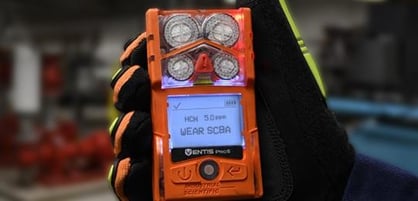Hydrogen Cyanide (HCN) Gas Detectors
Hydrogen cyanide (HCN) is a highly toxic chemical compound. It can be found in liquid form below 78°F (25.6°C) or as a colorless gas above 78°F (25.6°C). HCN is used in many processes, such as fumigating, electroplating, mining, chemical synthesizing, and producing synthetic fibers, plastics, dyes, and pesticides. Hydrogen cyanide may be released during reactions between cyanide and acid or during a nitrile fire or combustion. Hydrogen cyanide is extremely flammable and most often detected in its toxic form with an HCN gas detector.
.webp?width=2000&name=RAY_6149_MRCedits%20(1).webp)
Characteristics of Hydrogen Cyanide (HCN)
Hydrogen cyanide (HCN) is a colorless to pale blue liquid or gas. It has a distinct odor resembling bitter almonds. Hydrogen cyanide is particularly dangerous because of its toxic/asphyxiating effects on all life that requires oxygen to survive. HCN combines with the enzymes in tissue associated with cellular oxidation, rendering oxygen unavailable to the tissues and causing death by asphyxia. This suspension only lasts while the cyanide is present. Upon its removal, normal function is restored provided death has not occurred.
More about Hydrogen Cyanide


HYDROGEN CYANIDE - HCN
Effects of Various HCN Levels
Frequently Asked Questions
What is Hydrogen Cyanide (HCN)?
Hydrogen Cyanide (HCN) is a colorless, highly poisonous liquid or gas with a faint, bitter almond odor. It's used in industrial processes like fumigation, mining, and production of synthetic fibers, plastics, and dyes.
Why is Hydrogen Cyanide (HCN) detection important?
Detecting HCN is crucial due to its high toxicity. Even low-level exposure can be fatal. Early detection ensures safety in industrial settings, preventing harmful exposure and enabling prompt evacuation and medical intervention.
What are the health effects of Hydrogen Cyanide (HCN exposure?
HCN exposure can cause symptoms like headache, dizziness, weakness, nausea, and confusion. Severe exposure can lead to respiratory failure, cardiac arrest, and death. Immediate medical attention is critical.
How do you detect Hydrogen Cyanide (HCN)?
HCN is detected using gas detection instruments such as portable personal gas monitors and area monitors. These devices provide real-time monitoring to ensure workplace safety and compliance with occupational health standards. Industrial Scientific offers a range of HCN detectors, including both monitors and gas detection software.


